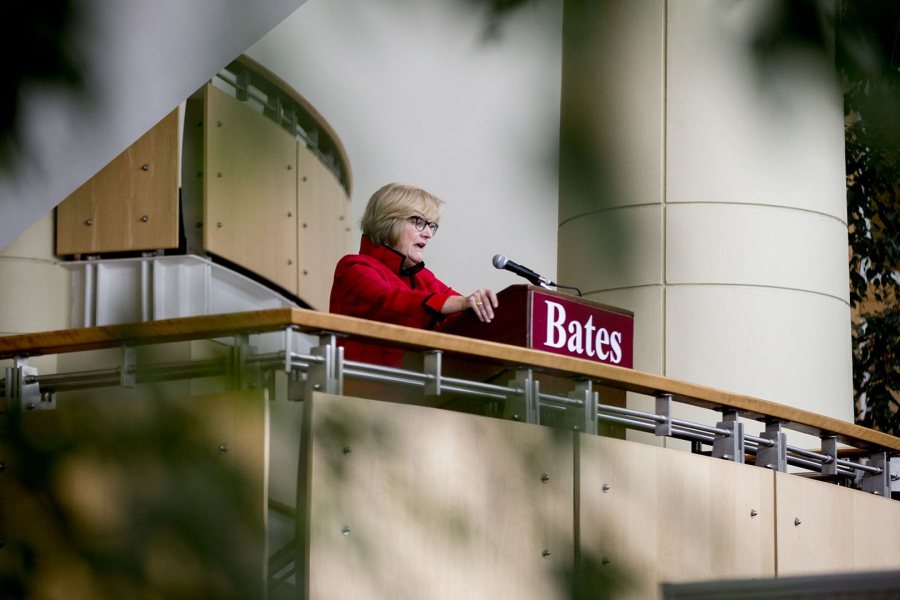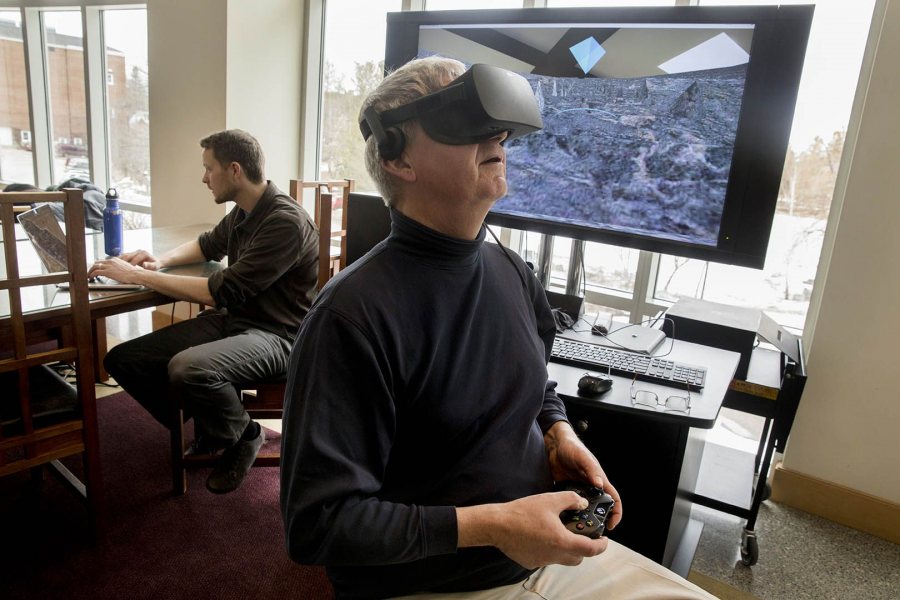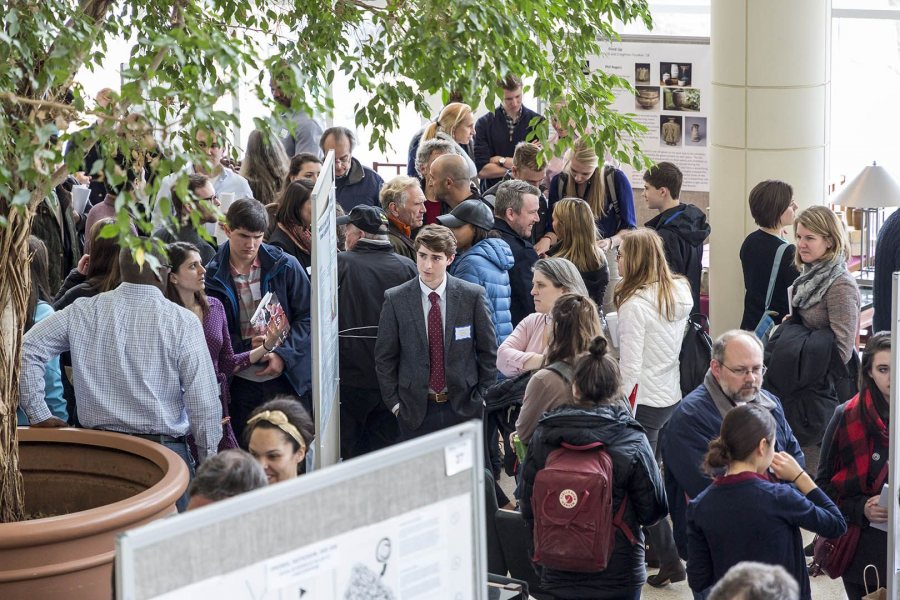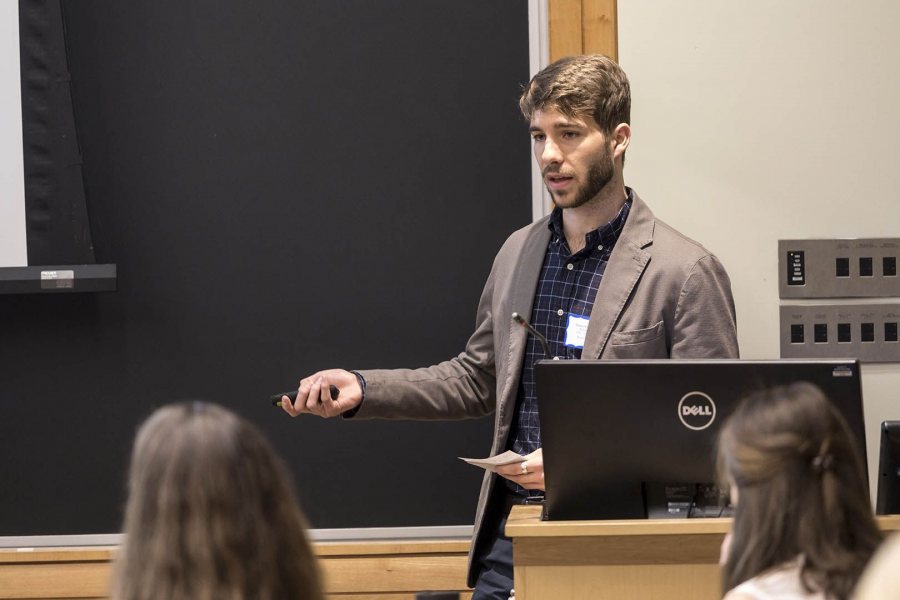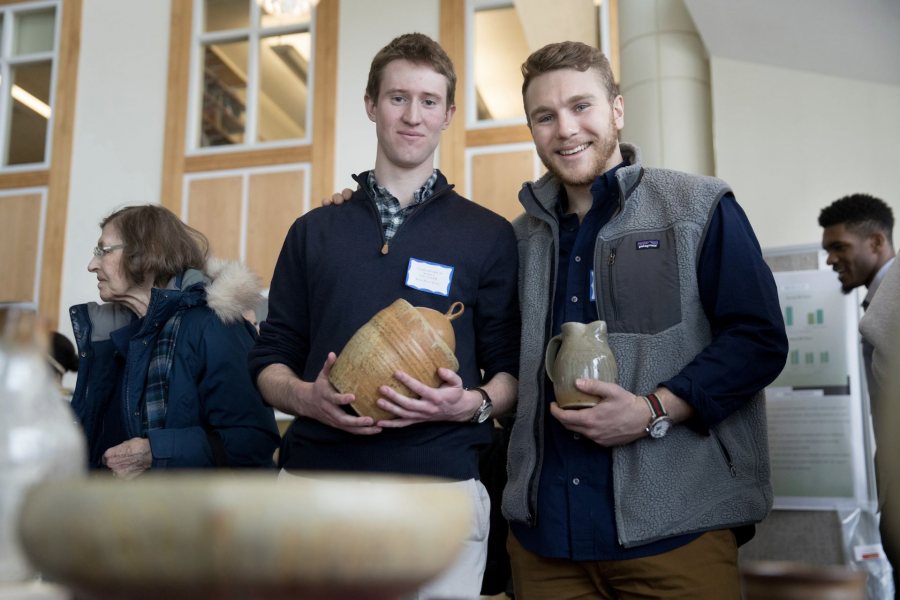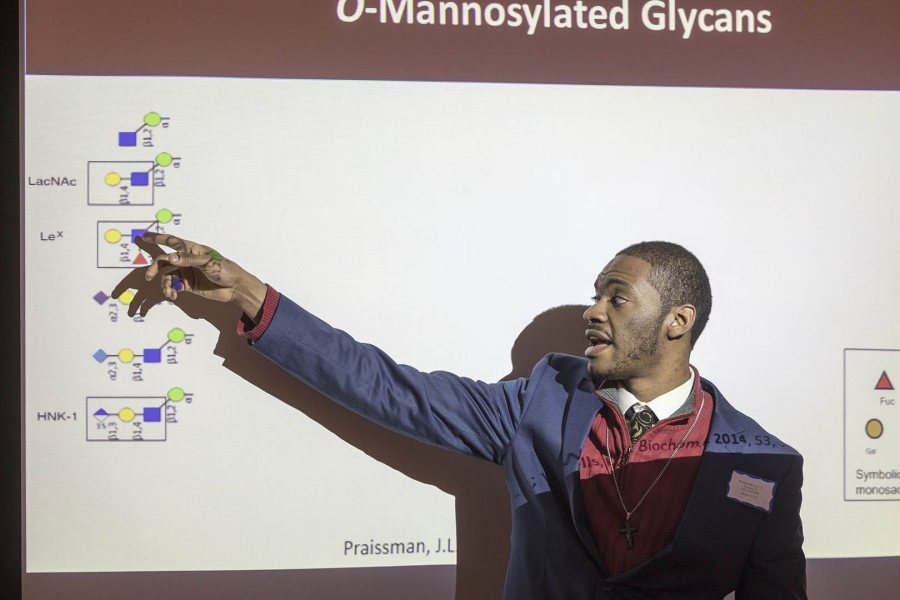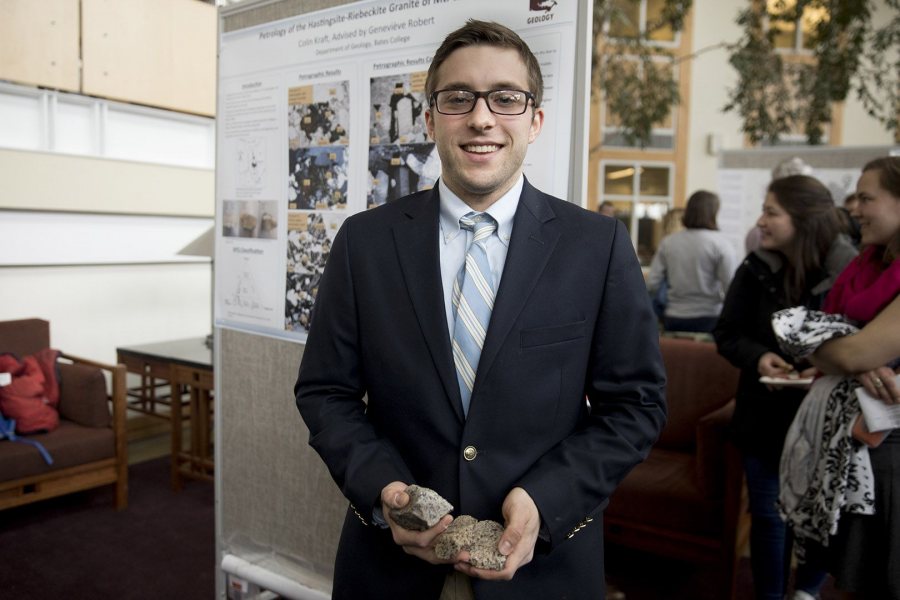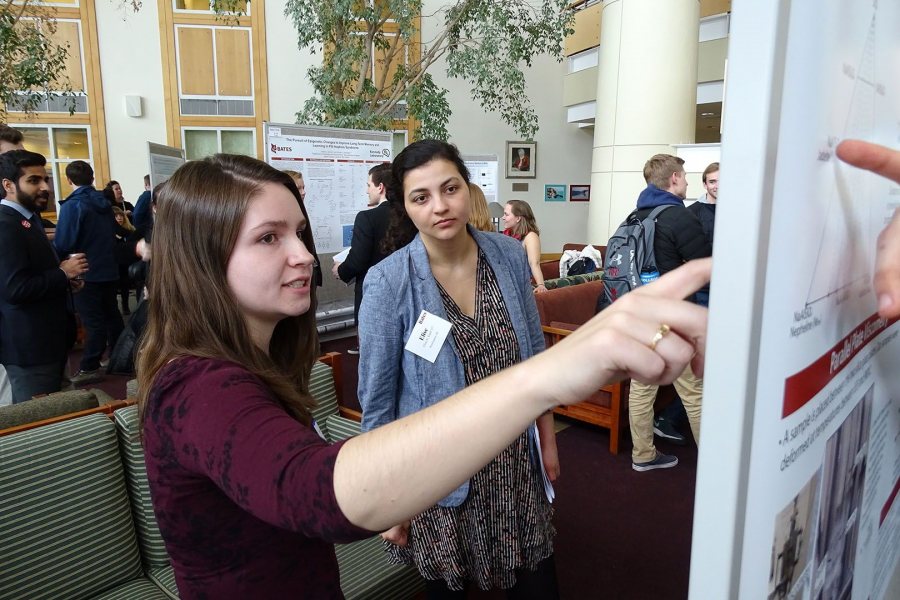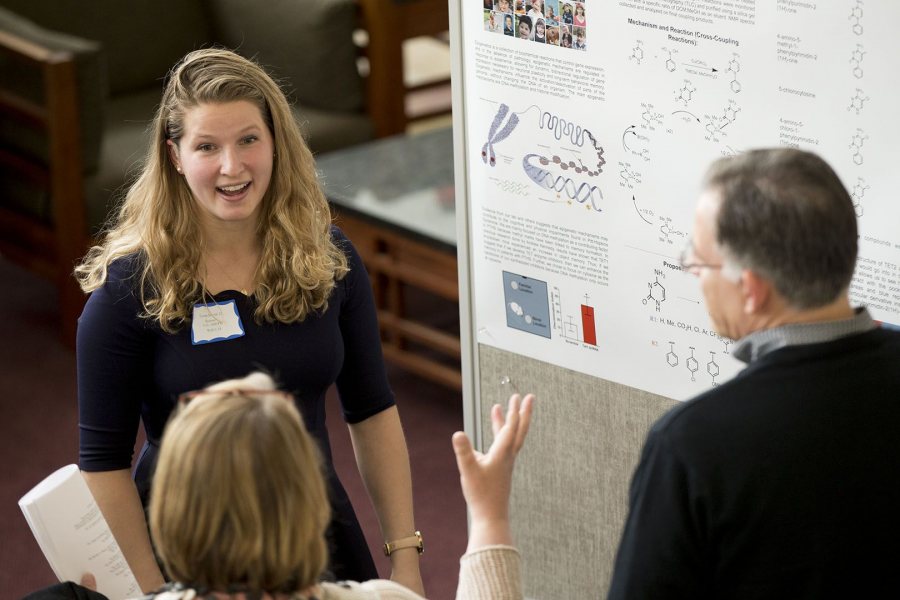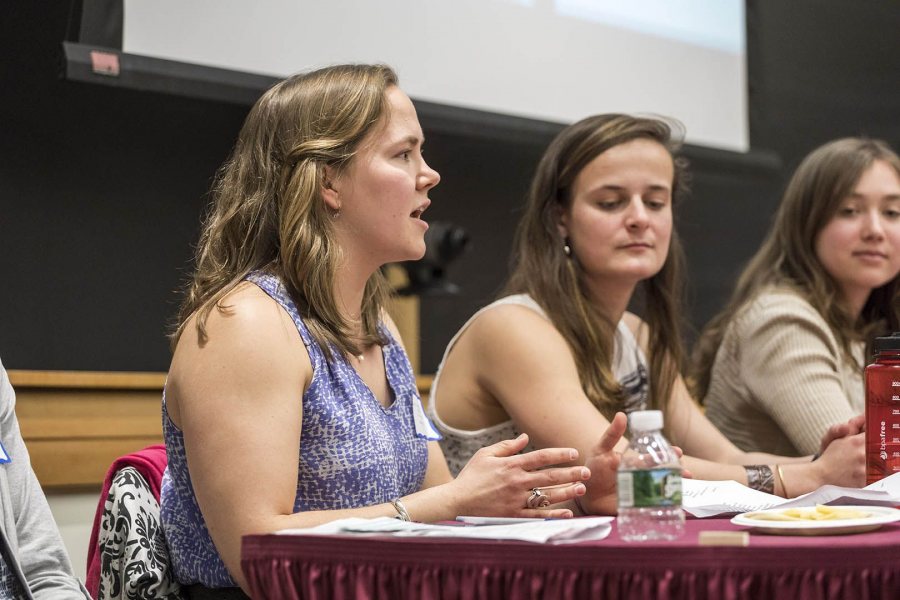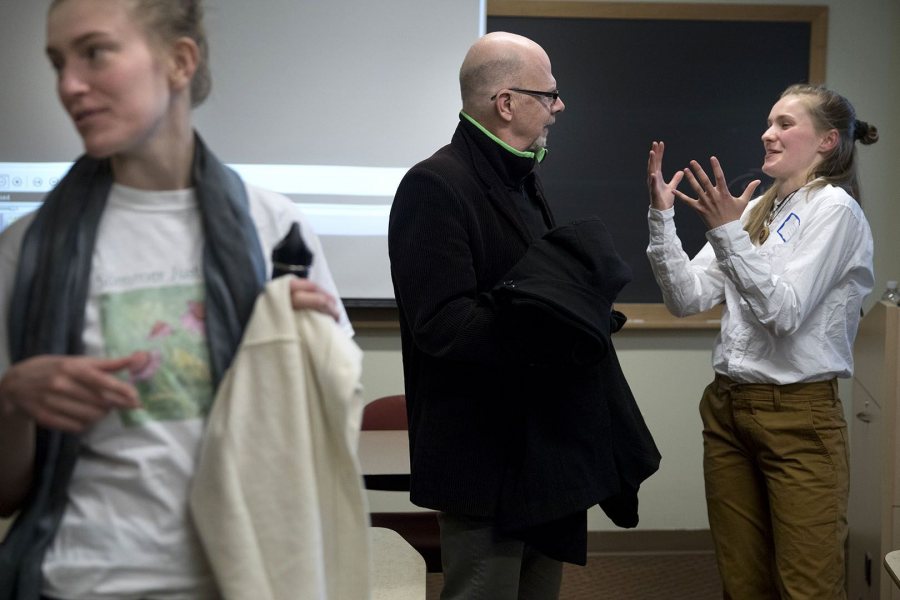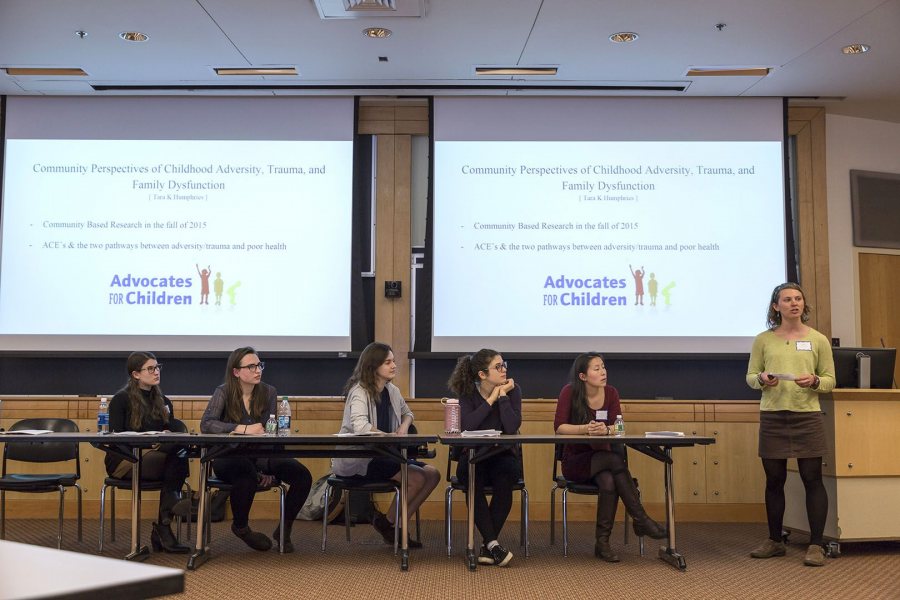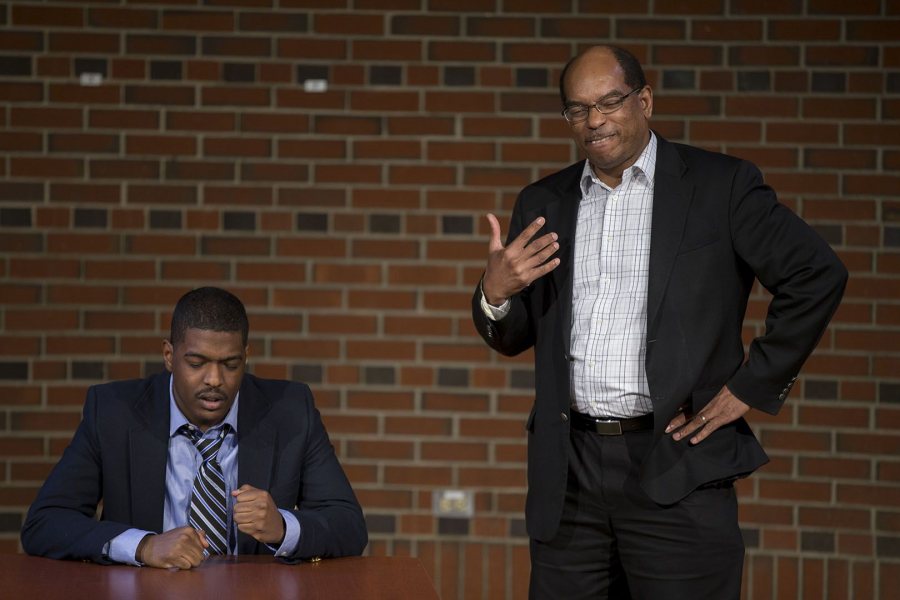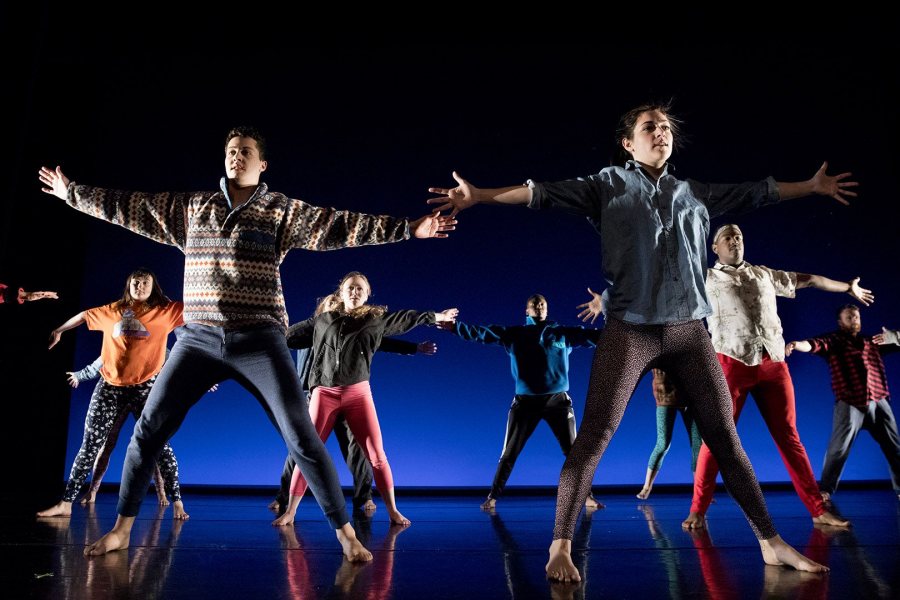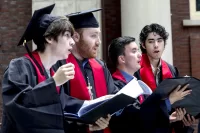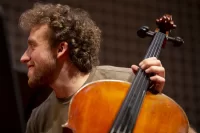
We’ve been to the summit and come back down with these stories, photos, and video from the 2017 Mount David Summit on March 31.
1:32 p.m. — Perry Atrium, Pettengill Hall
Offering the traditional “Call to the Summit,” the Bates Brass Ensemble gets the audience into the groove with “Swingtime” by John Wasson.
From left, Leah Sturman ’17 (French horn) of Huntington Beach, Calif.; Mike Connolly ’17 (trombone) of Duxbury, Mass.; Gabe Nelson ’20 (euphonium) of South Burlington, Vt.; ensemble director Alan Carr (trombone); Jamie Fagan ’20 (trumpet) of Wilton, Conn.; Grace Purinton ’20 (trumpet, obscured) of Berwyn, Pa.; and Kyle Zollo-Venecek ’17 (drums) of Concord, N.H.
1:37 p.m. — Perry Atrium
“I consider the Mount David Summit our intellectual March Madness, without the stress of bracketology,” says President Clayton Spencer in her summit welcome.
“Students will, with their posters, help you understand respiratory development, how viruses operate, how hard it is for galaxies to form stars — because who knew that star formation was complicated?”
“It is incredibly humbling to serve at an institution where our students are not only excellent students, but really wonderful people.”
1:42 p.m. — Perry Atrium
Professor of Politics Jim Richter checks out the ancient world via virtual reality, part of a demonstration mounted by students in “Rome and the East: Digitizing and Communicating History,” taught by Hamish Cameron, lecturer in classical and medieval studies.
As the course description promised, Cameron’s students would focus “not just on the collection and analysis of primary texts, but on the communication of the resulting sources and research in a public-facing digital format.”
1:43 p.m. — Perry Atrium
Perry Atrium, site of all poster presentations during the Mount David Summit, gets packed shortly after the summit’s start.
2:08 p.m. — Pettengill G65
In his presentation of psychology research, William Koller ’17 illustrates a common technique for measuring stress in an individual: heart rate variability.
Heart rate variability is different from heart rate: It’s a measure of the time between our heartbeats. High variability is a good thing, expressing an adaptability that accompanies calm and rest. The lower the variability — picture the steady heart thumping that comes with fear — the higher the stress.
Koller measured the heart rate variability of 62 Bates students as part of an experiment focusing on a condition called alexithymia, which is an individual’s inability to identify and label her or his own emotions.
Koller wanted to know whether, in people with symptoms of depression and/or anxiety, alexithymia plays a role in what’s known as emotional regulation: the ability to change one’s feelings — for the better, as the term is generally used.
Naturally, emotional regulation is important to healthy functioning. Deficiency in emotional regulation, in turn, is associated with various poor outcomes, and weak emotional regulation is a feature of depression and anxiety.
Measuring their heart rate variability with an electrocardiogram, Koller put his subjects through a series of exercises that included a stressful surprise in the form of an impromptu public talk. “People hated that,” he says, to laughter.
While Koller didn’t turn up the alexithymia–emotional regulation link he was hoping for, the experiment did reveal interesting phenomena — among them, a tendency in people with depression and/or anxiety to report feelings of stress that are at odds with their heart rate variability.
2:12 p.m. — Perry Atrium
Posing with their ceramic pots, Max Breschi ’18 of Carlisle, Pa., and Creighton Foulkes ’17 of Belmont, Mass., talked with summit-goers about the materials they used and their artistic process.
2:17 p.m. — Pettengill G10
William Browns Jr. ’17 of Westchester, Ill., presents his senior thesis research, which continues the work of his adviser, Associate Professor of Chemistry Jennifer Koviach-Côté, on O-mannosylated glycoproteins.
The glycocalyx influences particular biological processes, and it’s made up of individual and distinct glycans, including O-mannosylated glycans, which have “been found to be linked directly to cancer, multiple sclerosis, congenital muscular dystrophy, and many other diseases,” Browns says.
Browns looked at a less-studied type of O-mannosylated glycan from the M3 glycan family. In his research, he partially synthesized one of the “precursors” (a compound that takes part in a reaction that produces another compound) of GalNAc, which is a building block of the M3 glycan.
That accomplishment, he says, could ultimately allow for the glycosylation of the M3 glycan through automation.”
2:35 p.m. — Perry Atrium
Colin Kraft ’17 of Northborough, Mass., looks the part of the rock hound. Holding big rough chunks of granite in his hands, the geology major talks about his fieldwork and research on two kinds of granite, hastingsite and riebeckite, found on Mount Cabot in New Hampshire.
Asked about his post-grad plans, Kraft replies, “Graduate school in art history at Indiana University.” Come again?
Turns out that Kraft came to Bates “headstrong for geology,” he says. A Short Term course on modern architecture with Ned Harwood “blew me away.” Then he took more art history. “I loved the courses and the professors.”
So he majored in both, and his art-history thesis, advised by Rebecca Corrie, Phillips Professor of Art and Visual Culture, looks at illuminated manuscripts of the 1400s.
Such manuscripts have colorful and sometime elaborate decorations in the margins. Seeing one for the first time, Kraft recalls, “was just awesome.”
The connections between art history and geology are here and there. For example, Kraft has taken the course “The Art of Rock-Cut Architecture in Asia” from Associate Professor Trian Nguyen.
And both disciplines depend on close visual observation. Kraft points to the rich azure blue of riebeckite granite, which matches the blue used in so many illuminated manuscripts. “It’s actually one reason I wanted to look at riebeckite, besides its being rare,” he says. “It’s just a great blue. So rich.”
2:42 p.m. — Perry Atrium
Just the titles of some research posters are challenging enough.
Here, senior geology major Gwenyth Williams of Newbury, Vt., talks with classmate Elise Emil of Washington, D.C., about her poster, “Paleoenvironmental Reconstruction from the Sediment Record of the Varved Proglacial Linnévatnet, Svalbard.”
So we ask for a keep-it-simple, word-for-word explanation, and Williams happily obliges.
Paleoenvironmental: “Basically, the environment and climate of the past,” including precipitation and air temperature.
Reconstruction: “Going back from the present to the past to piece it all together.”
Sediment: Mostly, “grains of rock” that accumulate on the ground, like sand, silt, gravel, and other small fragments. “Anything that falls into that grain-sized classification.”
Record: “What we know.”
Varved: Describes a “sediment couplet” caused by the weather of a single year. In the frozen winter, for example, only very fine sediment might be deposited in a lake. But in the summer, “large-grained sediment is washed into the lake by stronger currents.”
Since the difference between the winter and summer layers can be seen, geologist can use varved lake sediments to track changes over time.
Proglacial: “In front of a glacier.”
Linnévatnet: The name of a lake, literally “Linne Lake,” the word “vatnet” being “lake” in Norwegian.
Svalbard: It’s the archipelago between Norway and the North Pole, explains Williams, where she did research with her adviser, Professor of Geology Mike Retelle. On a scale of 1 to 10, Williams says it was “about a 10. It was really fun.”
Specifically, Williams studied the varved sediment of the proglacial Lake Linné to look at environmental changes from the Little Ice Age (about 1300 to 1870) to the present era of warming.
2:53 p.m. — Perry Atrium
For every “Eureka” moment in scientific discovery, a scientist probably marches back to the drawing board a dozen times.
Emma Jarczyk ’17 of Boston worked with Assistant Professor of Chemistry Andrew Kennedy, who is doing groundbreaking work on a rare autism-spectrum disorder called Pitt Hopkins Syndrome
In fact, she helped Kennedy, new to Bates this year, do the physical setup for his lab in Dana Chemistry Hall.
Her thesis work involved helping to create, or synthesize, new compounds used in the lab’s experiments. As they tried to purify the compounds, the team discovered that their unexpected polarity made them “stick” to the walls of the purification column, literally a tube, “rather than flowing through and coming out as its purified self.”
And that wasn’t good. At first, she thought, “I’ve done all the research. I’ve spent all this time. Why isn’t this working?”
But, she says, “It’s also kind of exciting. You get to troubleshoot. You get to try to problem-solve.”
“That’s really what I enjoy about chemistry: I enjoy figuring out how things work. ”
Next year, she’ll be taking a break from lab work and working as an assistant in a dermatology practice “to get more experience in the healthcare realm. At this stage of my life, I know what I like, and I just need to decide what I want to apply it to.”
3:37 p.m. — Pettengill G21
During the panel discussion “Knowledge and the Public Good,” Katherine Stevenson ’17 presents her thesis research: She worked with Tri-County Mental Health Services and the Androscoggin County Jail to help those agencies understand the growing incidence of mental illness that they were noticing in the jail.
She spent more than 75 hours analyzing inmate medical records. “I then took that data and looked at it in the context of barriers to community-based mental health services in the county,” she says. “The short version of my findings is that over 70 percent of individuals at the jail have a substance abuse disorder and/or a co-occurring mental illness. This is slightly higher than the national average, which is around 64 percent.”
Stevenson, who designed her own major in peace and conflict studies, also identified barriers to care that include inadequate jail funding, inadequate referral systems, regulatory changes at the state Department of Health and Human Services, and eligibility restrictions for MaineCare, Maine’s Medicare system.
Stevenson and her five fellow panelists, each supported by Community-Engaged Research Fellowships from the Harward Center for Community Partnerships, explicitly tie their projects to the distinctive qualities of community-engaged research — and “connections” emerges as a theme for the presentation.
“What’s most salient for me is the idea of connection between the researcher and the community partner,” says Stevenson, whose thesis research has been cited in a state legislative hearing and presented to the Androscoggin County Commissioners.
“The things I’ve learned from people at both agencies have dramatically influenced how I’ve shaped my research, how I conducted it, and what information I found,” she tells the audience, which includes Androscoggin County Sheriff Eric Samson and Tri-County director Catherine Ryder.
3:45 p.m. — Pettengill G52
During the Q&A session that followed readings by eight seniors who have done creative-writing theses, Zaynab Tawil of Edmonds, Wash., is asked about her use of both Arabic and English in her poetry.
Arabic was her first language, she says, though “I’m better at English now,” adding that it feels “very important to integrate the languages” in her poetry. “I think there’s a sort of visceralness that you can only capture when you use the words in that specific language.”
In a poem like “Axis of Evil,” she says, the listener may “not understand what I was saying up here, but the sound and feel” of the Arabic words convey a “certain sentiment that would not come across if I were translating the exact words into English.”
Here, Tawil reads “Axil of Evil,” a poem inspired by a tension-fueled dream she had in Istanbul during the 2016 bombings. “Half-awake, sitting up my bed, I dreamed that a bomb had dropped in front of my balcony,” she recalls. “It was the first time that I confronted my own mortality. The poem is a product of that fear.”
4:32 p.m. — Pettengill 162
Woods Fairchild ’18 of Boston, Mass., talks with Associate Professor of Russian Dennis Browne after her presentation on how American and Danish students embody differently their role as college students.
Studying in Denmark, she interviewed Danish students and professors who have taught both Danish and American students. Specifically, she looked at how “students demonstrate motivation in times of academic struggle or curriculum dissatisfaction.”
She saw a distinction “between student perspectives, suggesting that these particular Danish students view their role as ‘guests’ in their education system, while Americans see themselves as consumers.”
The difference stems, perhaps, from “inherent differences between Denmark’s welfare system and American capitalism.”
Titled “Culture, Text, and Learning: Europe and the United States,” the panel also included presentations on German theater and on the Zen underpinnings of contemporary classical music. It was moderated by Assistant Professor of German Raluca Cernahoschi.
5:06 p.m.
Tara Humphries ’17 of North Yarmouth, Maine presents her sociology research on childhood trauma during a session moderated by Professor of Sociology Emily Kane.
The six panelists talked about a range of social issues, from the experiences of East Asian American youth to housing code enforcement in Lewiston.
Gabriella O’Leary ’17 of Wynnewood, Pa., talked about stereotypes of Muslim women held by Bates students.
Any stereotype is hard to dismantle, but her work found, interestingly, that stereotypes diminish when a student gets involved with the local Lewiston community (which has a large Muslim population), takes a class that focuses on the Muslim world, or develops a personal relationship with a Muslim woman.”
5:12 p.m. — Benjamin Mays Center
Brennen Malone ’17 of Philadelphia and Associate Dean of Students James Reese act in “Safety Measures,” part of the production of My America Too.
My America Too was originally produced by Center Stage in Baltimore as a series of six short plays set around a dinner table. The plays were filmed on the street at the sites of recent high-profile killings in Sanford, Fla.; Cleveland; Ferguson, Mo.; Staten Island, N.Y.; Baltimore; and Charleston, S.C.
The Bates production was directed by Justin Moriarty, assistant technical director in the theater and dance department, and featured Bates staff and students, including students in the independent study “Theater for Social Change,” advised by Kati Vecsey, senior lecturer.
7:30 p.m. — Schaeffer Theatre
In the evening, the Bates Dance Company, seen here in their Thursday night rehearsal, begins the four-performance run of its spring dance concert, this year titled what we find.
Meanwhile, across the Puddle in the Olin Arts Center, the Bates College Choir and Orchestra perform the second and third parts of Handel’s Messiah. What a day at Bates!
